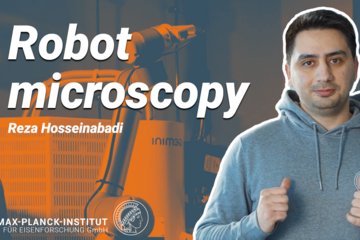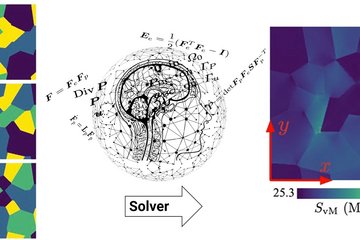All genres
461.
Conference Paper
Study of Carbide Formation in a Mechanically Alloyed Copper-Titanium-Graphite Blend. In: Advances in Powder Metallurgy and Particulate Materials - 1996, Vol. 1, pp. 2-59 - 2-68 (Eds. Cadle, T.; Narasimhan, K. S.). 1996 International Conference on Powder Metallurgy and Particulate Materials, Washington, DC, USA, 1996. Princeton, NJ, Metal Powder Industries Federation; APMI International, New York (1996)
462.
Conference Paper
Problems in Interpreting Sub-Å-Resolution Images Studied by Simulated Evolution Based Digital Image Matching. In: MSA 1995: Proceedings Microscopy and Analysis 1995, pp. 638 - 639. Microscopy Society of America, 53rd Meeting, Kansas City, MO, USA, August 13, 1995 - August 17, 1995. Microscopy Society of America, USA (1995)
463.
Conference Paper
Structure of Copper/Sapphire Interfaces. In: Electron Microscopy 1994: Proceedings of the 13th International Congress on Electron Microscopy, Applications in Materials Sciences, Vol. 2A-2B, pp. 277 - 278 (Ed. Jouffrey, B.). 13th International Congress on Electron Microscopy , Paris, France, July 17, 1994 - July 22, 1994. Les Editions de Physique; 1994 (1994)
464.
Conference Paper
A Novel Rear Side Configuration for Ultrathin Crystalline Silicon Inversion Layer Solar Cells. In: Eleventh E.C. Photovoltaic Solar Energy Conference: Proceedings of the International Conference, pp. 237 - 240 (Ed. Adelhelm, P.). 11th International conference of photovoltaic solar energy, Montreux, Switzerland, October 12, 1992 - October 16, 1992. Harwood-Academic Publishers, Chur, Switzerland (1994)
465.
Talk
TEM based characterization of defects in alloys. Autumn School of Electron Microcopy 2024, Brno, Czech Republic (2024)
466.
Talk
Effects of Grain Boundary Structure and Chemistry on Plasticity in Metals. Nanomechanical Testing in Materials Research and Development IX, Messina (Sicily), Italy (2024)
467.
Talk
Towards Understanding Dislocation Strengthening Mechanisms of Cr(Mn)FeCoNi high entropy alloys by advanced (S)TEM. ELMINA 2024, Belgrade, Serbia (2024)
468.
Talk
Micromechanical Testing of Diffusion Couples to Study the Deformation of B2 FeAl as a Function of Al Content. MSE 2024, Darmstadt, Germany (2024)
469.
Talk
Triggering and tracking grain boundary phase transformation at atomic resolution. European Microscopy Conference EMC 2024, Copenhagen, Denmark (2024)
470.
Talk
Exploring the Relationship Between Grain Boundary Structure and Chemical Composition at the Atomic Level. International Conference on Intergranular and Interphase Boundaries in Materials (IIB 2024), Beijing, China (2024)
471.
Talk
Atomic resolved imaging of grain boundary phase transitions in pure and alloyed metallic thin films. 17th International Conference on Intergranular and Interphase Boundaries in Materials (IIB 2024), Beijing, China (2024)
472.
Talk
A Micromechanical Study on the Correlation of Composition and Properties of B2 FeAl across the Interface of an Fe–Al Diffusion Couple. ECR Day, Ruhr Universität Bochum, Bochum, Germany (2024)
473.
Talk
Compression of dewetted Nickel microparticles at ultra-high strain rates. 19th European Mechanics of Materials Conference, Madrid, Spain (2024)
474.
Talk
Strengthening of CoCrFe(Mn)Ni high entropy alloys by dislocation pinning: From Lattice friction & SRO to particle strengthening. Possibilities and Limitations of Quantitative Materials Modeling and Characterization 2024, Bernkastel-kues, Germany (2024)
475.
Talk
Influence of a low angle grain boundary on high strain rate deformation in Copper. MecaNano, Vienna, Austria (2024)
476.
Talk
Boosting mechanical properties of thin film high entropy alloys through nanoengineering design strategies. 16th International Conference on Local Mechanical Properties, Prague, Czech Republic (2024)
477.
Talk
Exploring micro-/nano- mechanical behaviour at extreme strain rates. TMS Annual Meeting and Exhibition 2024, Orlando, FL, USA (2024)
478.
Talk
Influence of the Structure and Chemistry of Σ5 Grain Boundaries on Microscale Strengthening in Cu Bicrystals. TMS Annual Meeting and Exhibition 2024, Orlando, FL, USA (2024)
479.
Talk
Universality of grain boundary phases in [111] tilt boundaries of fcc metals. TMS 2024 Annual Meeting & Exhibition, Orlando, FL, USA (2024)
480.
Talk
Elevated temperature deformation of intermetallic phases in Mg–Al–Ca alloy at small length scale. International conference on creep and fracture of engineering materials and structures, Creep 2024, Bangalore, India (2024)











